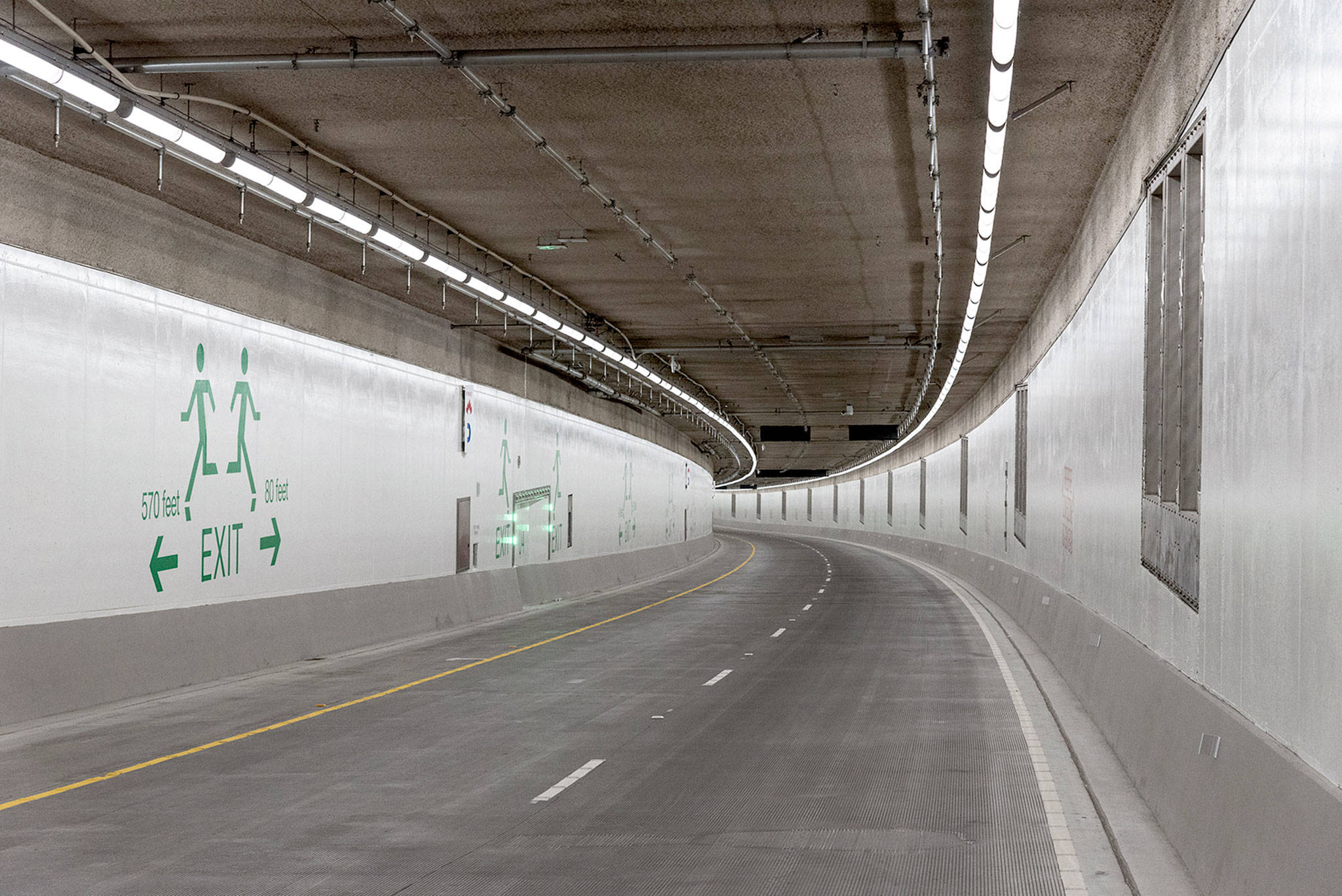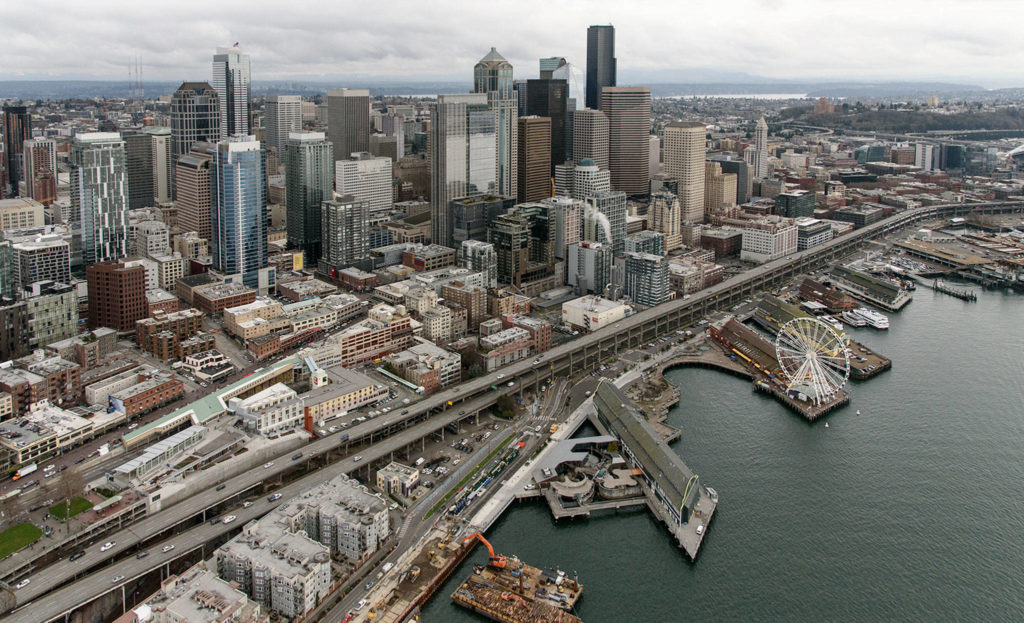By Mike Lindblom / The Seattle Times
SEATTLE — Seattle’s waterfront Alaskan Way Viaduct, in service since 1953, will be replaced this winter by a four-lane Highway 99 tunnel between Sodo and South Lake Union.
If you’re new around here, perhaps you don’t know about the 18 years of citizen forums, design studies, arguments, advisory ballot measures, mechanical breakdowns and digging by the massive tunnel-boring machine Bertha, to finally arrive at a completed tunnel.
Or maybe you just wonder how people will travel when the tunnel makes some trips more direct, and other trips more circuitous.
The Seattle Times has received questions from nearly 600 readers about the tunnel project. They range from the cost of tolls and how much traffic will use the tunnel to who decided to build it, anyway?
Here are some answers:
When does the viaduct close and the tunnel open for traffic?
The viaduct closes for good Jan. 11, 2019. The tunnel will open sometime during the week of Feb. 3-9, said Dave Sowers, deputy Highway 99 administrator for the Washington State Department of Transportation (WSDOT). That means travelers will have no viaduct and no tunnel for three weeks to cross downtown.
Why close the viaduct three weeks before the tunnel opens?
Contractors need time to pave new ramp connections from Aurora Avenue to the north tunnel portal, and from Sodo Highway 99 to the south portal. This work crosses highway lanes, forcing a full closure, along with traffic snarls entering central Seattle.
When will the viaduct be torn down?
Demolition should begin in January or February, and last until June or beyond.
How will they demolish the viaduct?
The $40 million task, awarded to Kiewit Infrastructure West, could require four months or longer — compared to nine days in October 2011 to level a mile of viaduct in Sodo.
This is mainly because of tight spaces, including sidewalks and buildings within 10 feet of the viaduct. Demolition teams will hang mesh curtains to shield windows from flying debris, when the munching claws get down to business. Most of the 397 foundations must be severed 5 feet underground. Truck routes to haul debris are narrow and may conflict with traffic.
Early plans call for as many as five work teams to speed up the job, as well as concrete-breaking until 10 p.m. Seneca Street and Western Avenue ramps will remain awhile so equipment operators can drive onto the elevated decks. Road decks near Pike Place Market might be removed first so the city can start building its Overlook Walk from the market down to the Seattle Aquarium.
What’s the cost of this project to taxpayers?
The state budget for the tunnel, interchanges, viaduct demolition and rebuilt waterfront Alaskan Way totals $3.3 billion, covered mostly by $2 billion in state gas taxes. The federal government contributed $787 million and the Port of Seattle $268 million. Tolls are supposed to provide $200 million plus maintenance expenses.
However, contractors have sued the state and insurance companies for up to $600 million more, to cover more than two years of delay and repairs when tunnel-boring machine Bertha broke down in December 2013. Months or years of lawsuits remain, before we know what share of cost overruns is paid by Washington state drivers.
The Highway 99 tunnel and Highway 520 bridge replacement rely on borrowing so drivers will be paying off the debts until the early 2040s.
Who were the key people involved in picking the tunnel?
By the time the state chose a tunnel to replace the viaduct, it had already spent seven years and $325 million for publicity, engineering studies, environmental reports and administration to evaluate a purported 75 elevated, surface, shallow-tunnel and small-tube options, then eight finalists.
Then-Gov. Christine Gregoire ended the process by choosing a single-bore tunnel following stakeholder meetings and closed-door talks in late 2008. Some other influencers were:
• WSDOT Secretary Paula Hammond: signed the $1.44 billion tunneling contract in 2011 with Dragados USA and Tutor-Perini companies, under the name Seattle Tunnel Partners.
• Harvey Parker and John Reilly: tunnel-industry evangelists and project leaders, who convinced Washington state officials a world record 57-foot, 3-inch tube was feasible.
• Bruce Agnew: director of the Cascadia Center think tank, who organized a forum and conversations among local leaders and tunnel-industry executives.
• Ed Murray: Seattle Democrat and prime sponsor of the state deep-tunnel legislation, while chairman of the Senate Transportation Committee.
• Ron Paananen: WSDOT project administrator when the tunnel was chosen. Currently a private-sector consultant on Highway 520.
• Judy Clibborn: state House Transportation Committee chairwoman from Mercer Island, who consistently supported tunnel funding, even when costs rose.
• Tayloe Washburn: attorney and Seattle Chamber of Commerce representative who led the stakeholder group that wound up endorsing a tunnel.
• Jan Drago: Seattle City Council member who claimed credit for keeping a deep-tunnel option in play, while public advisory ballots rejected a new viaduct and a shallow tunnel. Councilmembers Richard Conlin and Tom Rasmussen prominently endorsed and defended the tunnel plan amid citizen opposition.
• Bob Donegan: president of Ivar’s restaurants, who argued that shallow-tunnel and viaduct options would ruin waterfront commerce by closing segments of Highway 99 and trenching Alaskan Way for years.
How wide is the tunnel roadway?
There are two 11-foot-wide southbound lanes on the upper deck and two 11-foot northbound lanes on the lower deck.
An 8-foot shoulder is on the waterfront side of both decks — right for southbound, left for northbound. Shoulders are positioned that way because the emergency-evacuation doors and passageway were built along the waterfront side of the tunnel. On the inland side, the shoulder is 2 feet.
Overhead clearance is 15 feet and 9 inches below the traffic-message signs.
What’s the speed limit?
The posted limit is 45 mph, to be reduced by electronic lane signs when traffic is heavy. Seattle police are responsible for enforcement.
Are there downtown exits?
No. The viaduct’s mid-downtown ramps at Seneca Street and Columbia Street will not be replaced. In Belltown, the northbound exit at Western Avenue and southbound entrance at Elliott Avenue also won’t be replaced.
However drivers can exit the tunnel at South Lake Union and head south across Denny Way toward downtown. Or take the Sodo interchange and take First Avenue South or Alaskan Way South north to downtown. Both interchanges include the word “Downtown” on their green exit signs.
How much is the toll?
Tunnel trips will be free until sometime mid-2019.
Then rates will vary by time-of-day, from $1 each direction in overnight hours to $1.50 for the morning commute and $2.25 at afternoon peak. They’re set cheap, so drivers are less likely to divert onto clogged city streets and Interstate 5. Private transit and registered vanpools are free, but carpools will pay the toll.
Overhead scanners charge the toll as vehicles travel full speed, as on the Highway 520 bridge.
Motorists need a windshield-mounted Good to Go pass to avoid a $2 surcharge per trip, billed by mail.
How much traffic will use the tunnel?
A new state forecast says the tunnel would serve 97,400 vehicles per day if it were toll-free, which exceeds the 91,000 that currently pass the viaduct’s busiest point above Yesler Way.
WSDOT says demand will be robust because people can drive the tunnel and backtrack from its endpoints toward downtown. For others, the tunnel offers a straight shot past downtown with less weaving or congestion than the viaduct, so it may create new trips.
But WSDOT also estimates 44,000 drivers would divert once tolls are charged — even though they’re only $1 to $2.25. Ed Barry, tolling director, said diversion assumptions were highballed out of fiscal caution. WSDOT preferred to skew tunnel usage low, to be comfortable about toll revenues meeting the capital and maintenance requirements.
What about people who don’t want to drive in the tunnel?
A lack of downtown exits, claustrophobia, or tolls in mid-2019 might prod some drivers to avoid the new tunnel.
Their other options include driving the newly repaved four-lane Alaskan Way on the waterfront, though viaduct demolition and road construction will often crimp some segments to two lanes.
First and Fourth avenues remain available but will be more crowded than usual, at least until waterfront bus lanes and increased Sound Transit light-rail capacity arrive in 2021. Interstate 5 is expected to absorb some traffic that diverts from Highway 99.
The new Sodo interchange won’t be ready for West Seattle and Burien drivers northbound into downtown until mid-February, which worsens the short-term pain. It’s unclear whether drivers to Interbay, Magnolia and Ballard will lose more time driving on surface streets past downtown, or driving the tunnel before turning west at Mercer Street, or surface roads across Fremont or Phinney Ridge.
Talk to us
> Give us your news tips.
> Send us a letter to the editor.
> More Herald contact information.


























